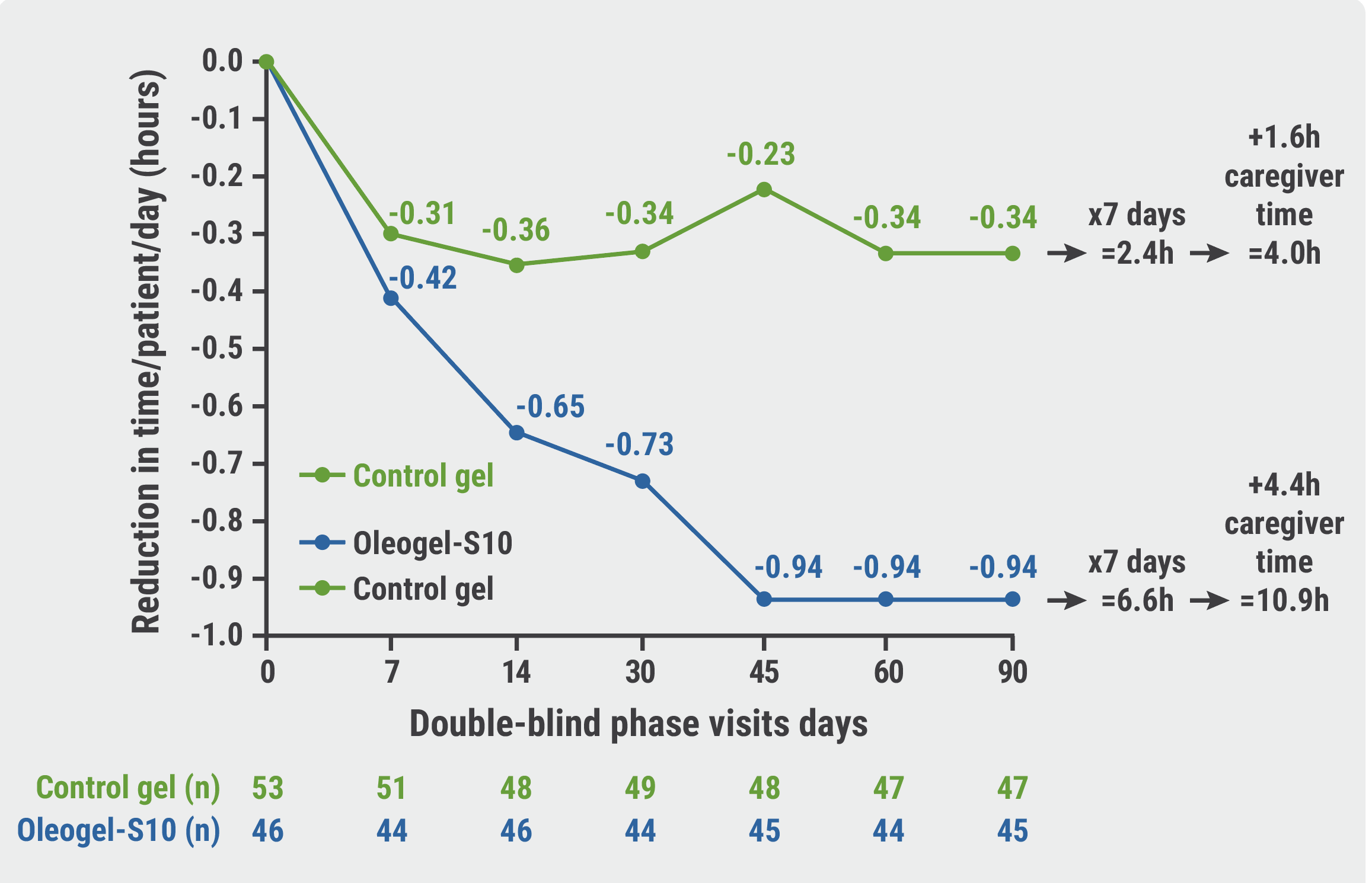https://doi.org/10.55788/b70ef049
Epidermolysis bullosa is a rare genetic disease characterised by skin fragility and blister formation in response to minimal trauma. As there is no causal treatment, management focuses on demanding wound care with frequent and painful dressing changes.
Previously, the birch bark extract-containing wound gel Oleogel-S10 led to a higher proportion of patients with complete closure of the target wound within 45±7 days in the randomised, double-blind, vehicle-controlled, phase 3 EASE trial (NCT03068780). This was the first trial to demonstrate the clinical benefit of any agent in the rare genetic disease epidermolysis bullosa. Prof. Dimitra Kiritsi (University of Freiburg, Germany) presented the current analysis that aimed to assess the impact of Oleogel-S10 treatment for those patients that are most severely affected, namely those that required daily dressing changes at baseline [1].
The analysis included 46 participants receiving Oleogel-S10 and 53 participants receiving the control gel. “There was no change in daily dressing changes with the control gel, while in the other group, the number of those who did not need daily changes increased and was significantly different from the control at day 45, 60, and 90,” Prof. Kiritsi said. At that time, 35.6% of participants in the intervention arm had a reduced requirement for daily dressing changes compared with 10.6% in the control group. This translates to almost 3 fewer dressing changes every 2 weeks for participants treated with the birch gel.
Prof. Kiritisi emphasised that this difference is a relevant clinical benefit not only for the patient but also for their caregivers. Compared with historical data, the estimated time saved on dressing changes per week for patients in this cohort was 10.9 hours in the intervention group (6.6 hours for each patient and 4.4 hours for their caregiver/assistant) versus 4.0 hours for those applying the control gel (see Figure) [1,2]. “This is important for our patients: this is time they can be doing something nice with their family and not be in pain,” Prof. Kiritsi concluded.
Figure: Time saved on dressing changes for patients and caregivers [1,2]

- Kiritsi D, et al. Oleogel-S10 reduces dressing changes burden in patients with epidermolysis bullosa. D3T01.3H, EADV Congress 2023, 11–14 October, Berlin, Germany.
- Bruckner AL, et al. Orphanet J Rare Dis 2020;15:1.
Copyright ©2023 Medicom Medical Publishers
Posted on
Previous Article
« Women with psoriasis face increased adverse effects with systemic therapy Next Article
Remibrutinib reduces itch, sleep problems, and activity impairment in patients with CSU »
« Women with psoriasis face increased adverse effects with systemic therapy Next Article
Remibrutinib reduces itch, sleep problems, and activity impairment in patients with CSU »
Table of Contents: EADV 2023
Featured articles
Tapinarof on course to become a new topical treatment in AD
AD and Eczema in 2023
Tapinarof on course to become a new topical treatment in AD
Upadacitinib provides sustained skin clearance in adolescents and adults with AD
Sustained deep clinical and itch responses with novel IL-13 inhibitor
IL-13 inhibitor shows potential in atopic dermatitis
Encouraging results for amlitelimab in atopic dermatitis
Chronic hand eczema: patients share similar molecular signatures regardless of AD status
Severe hand eczema: dupilumab could be a future treatment
Psoriasis News
Dual IL-17 blockade yields efficacy on joints and skin
High-dose subcutaneous spesolimab prevents GPP flares up to week 48
Drug survival of guselkumab and risankizumab seems superior to other biologics
IL-23 blockers may lower the risk of developing inflammatory and psoriatic arthritis
First-in-class oral IL-23 inhibitor safe and effective for moderate-to-severe plaque psoriasis
Hidradenitis Suppurativa: End of the Diagnostic and Therapeutic Draught
Skin tape stripping allows a novel precision medicine approach in HS
Nanobodies: A novel way to treat HS
Anti-IL17 blockade leads to maintained pain reduction in patients with HS
Vitiligo: Novel Treatment Options
JAK1 inhibition: a promising forthcoming treatment option in vitiligo
Vitiligo: Continuation of topical ruxolitinib successful in many initial non-responders
Alopecia Areata: Novel Developments
JAK3/TEC inhibition achieves clinically meaningful responses in AA
Alopecia areata: remarkable regrowth rates with deuruxolitinib
Botanical drug solution improves hair regrowth in children and adolescents with AA
What’s New in Other Disease Entities
Nemolizumab shows high success rates in prurigo nodularis
Remibrutinib reduces itch, sleep problems, and activity impairment in patients with CSU
Innovative wound gel reduces frequency of painful dressing changes in epidermolysis bullosa
Best of the Posters
Women with psoriasis face increased adverse effects with systemic therapy
Improved AI tool shows high sensitivity rates in skin cancer detection
Dermoscopy training combined with AI significantly improves skin cancer detection
Related Articles
October 9, 2019
Above-the-neck melanoma more prone to metastases
May 10, 2023
OCT non-inferior to biopsy in basal cell carcinoma
December 2, 2021
Expanding the toolbox: what is new in melanoma detection?
© 2024 Medicom Medical Publishers. All rights reserved. Terms and Conditions | Privacy Policy

